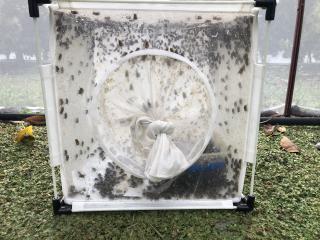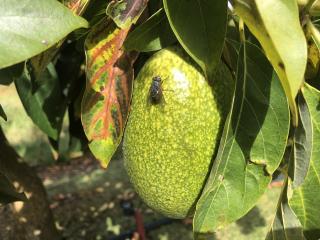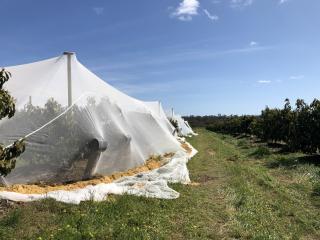Native flies are showing potential as a supplementary pollinator to bees in avocado trees grown in Western Australia’s South West.
The Department of Primary Industries and Regional Development (DPIRD) is leading the national research project, funded by Hort Innovation with partners from across Australia.
The third year of trials was expanded this year from an orchards in Busselton to include another new orchard at Pemberton, which all grow the Hass variety of avocadoes.
Each site hosts three purpose-built enclosures, containing 21 trees each at Busselton and 25 at Pemberton, which has a higher tree density.
On each property, one enclosure was populated with about 5000 western golden-haired flies (Calliphora albifrontalis), one with the western blue-bodied fly (Calliphora dubia) and – for the first time – a managed honey bee hive (Apis mellifera).
DPIRD research scientist David Cook said this year’s research sought to verify previous results from the first two years of the trial.
Dr Cook said the results showed pollination exclusively by native flies produced yields two thirds of that achieved via open pollinated trees, where flowers could be pollinated by either bees and other insects in the orchard.
“Results from the past field trials showed the blue-bodied fly to be the most effective pollinator, visiting flowers three times more often than the western golden-haired fly and producing three times as much fruit as western golden-haired flies,” he said.
“If something were to happen to the bee populations sourced by orchardists, like a new pest or if a disease of bees and hives was introduced into Australia, then at least growers would have a viable other insect species they could use for pollination.”
The scientists discovered that native flies in enclosures were particularly useful in pollinating Hass avocado flowers, which open as female one day, then male flowers the next.
“Flies that visit a male flower and pick up pollen while feeding can then transfer the pollen to a female flower nearby,” Dr Cook said.
“As there are no other sources of sugar available to the flies in the enclosures, they feed on the flowers regularly throughout the day.
“This means there is an increased chance of the male and female flowers being open for pollination, optimising the potential for fruit to be set.”
While researchers will not know the results from the trial until the avocadoes are harvested in June, an examination of fruitlets about two centimetres in diameter or bigger on the trees will provide a good indication of the future yield potential.
“In previous years the fruitlet count of marble-sized fruit in the fly enclosures gave a good indication of future yield, as they did not have a typical fruit drop event that often occurs with trees out in the open,” Dr Cook said.
“Clearly the native flies were doing a good job of pollinating.”
The WA component of the project is also examining the performance of native flies as pollinators in blueberry crops, which has already produced encouraging results from trials at Busselton and the department’s South Perth glasshouse.
While the western golden haired fly performed well in 2018, in 2019 the western blue-bodied fly performed even better, increasing total yields by 36 per cent and berry size by five per cent.
“In this year’s blueberry trials we were looking to verify those results, as well as assess how long the flies remain in the enclosures and examine measures to encourage them to linger in the cropping area, such as protein lures,” Dr Cook said.
“The warmer than average winter meant that chilling temperatures below seven degrees centigrade were rarely experienced and the level of flowering was significantly less than normal, producing inconsistent trial results compared with previous years.”
The other project partners Western Sydney University, The University of New England, The University of WA, SeedPurity Pty Ltd and Biological Services are examining the performance of native flies in avocadoes, mangoes, seed crops and strawberries.
Stage two of the project in years four and five will develop rearing techniques for mass production of each species so they can be applied commercially in the horticulture sector.
This work will involve determining the x-ray radiation dose required to render native flies unable to reproduce to ensure there is no increase in the natural population of flies or displacement of other insect species, such as hover flies.
The Managing Flies for Crop Pollination project is funded by the Hort Frontiers Pollination Fund, part of the Hort Frontiers strategic partnership initiative developed by Hort Innovation, with co-investment from the Department of Primary Industries and Regional Development, Western Australia, The University of WA, Western Sydney University, University of New England, Seed Purity Pty Ltd and Biological Services and contributions from the Australian Government. It has also been funded by Hort Innovation, using the avocado research and development levy and contributions from the Australian Government. Hort Innovation is the grower-owned, not-for-profit research and development corporation for Australian horticulture.



Media contacts:
Jodie Thomson/Megan Broad, media liaison
+61 (0)8 9368 3937
